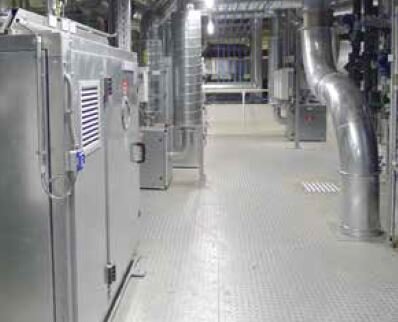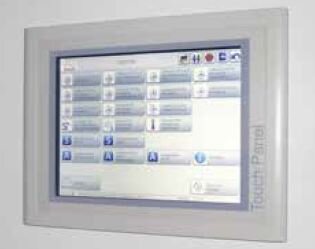Ponad 100 lat poświęconych postępowi technicznemu - tak najprościej można opisać naszą działalność w zakresie technologii robotycznej i automatyki Yaskawa.
Good climate at the new Audi plant
Challenge
Building automation with Yaskawa Vipa control technology
Audi Hungaria Motor Kft. in Györ, Hungary, has been developing and producing engines for Audi AG and other members of the Volkswagen Group since 1993. The company also started serial production of the Audi A3 limousine in June 2013; the new Audi A3 cabriolet followed in October of the same year. The two members of the A3 family are the first Audi models to be manufactured completely at the Hungarian location. In addition, the Audi TT will soon be rolling off the assembly line as a coupe and roadster. For this purpose, Audi built a new car manufacturing plant with a complete production line – from the pressing plant to the body shop, paint shop and assembly. The new factory will be turning out 125,000 cars per year.
Since its founding more than 20 years ago, Audi Hungaria Motor Kft. has become one of the largest exporters and joined the ranks of the country’s highest revenue companies. With a total investment volume in excess of €6.7 billion, today Audi is one of the most important foreign investors in Hungary and one of the region’s largest employers: the company employs a workforce of over 10,000.
Solution
Vipa controls part of the building automation
Yaskawa Vipa control units constitute about 40% of the building automation equipment in the new plant. Concept, process control engineering and implementation were entrusted to Prozesstechnik Kropf GmbH, based in Oberkotzau, Upper Franconia. Yaskawa Vipa and Kropf share a long-standing professional bond through numerous building automation projects, primarily in the automotive sector. The construction of switch cabinets for the new Audi plant lay partly in the hands of the Upper Franconians: Hermos Schaltschrankbau from Mistelgau in Upper Franconia. Here again, long-term business relations exist between Yaskawa Vipa and Hermos. Another figure relating to the dimensions of automation and control technology at the Györ plant: all in all, more than 200m of switch cabinets have been installed here.
In Györ the following areas were equipped with Yaskawa Vipa control units by Prozesstechnik Kropf:
- Power distribution and ventilation systems for the body shop, paint shop, assembly and pressing plant with a Zenon control system; 56 Vipa-CPUs were deployed here alone
- Various extraction units, e.g. on two aluminum grinding machines inside the body shop G50 and logistics G50 in the truck loading and unloading zone. The latter is for CO monitoring. Building control also included hall air conditioning and the regulation of cold, cool and hot water, compressed air and gas supplies. The control units are housed in 62 switch cabinets, covering the following areas:
Body shop G50: 20 ventilation systems that can also function as smoke extractors with the control of valves, flaps and fans. The ventilation capacity is between 75,000 and 1.2 million m³/h.
Paint shop G60: four ventilation systems and a ventilation system for ancillary rooms such as office, canteen, SB shop.
The CPU 315-4NE12 was installed as central CPUs for PROFIBUS and Ethernet communication and the CPU 315-4PN12 for PROFIBUS and PROFINET communication. Communications via PROFIBUS and Modbus protocols and via EnOcean are decentralized. The decentralized configuration was implemented with CPUs, communication processors and slaves from the VIPA 200V family and communication processors and slaves from SLIO family, together with the respective digital and analog signal modules.
10” TP610C touch panels from VIPA are used for operation and monitoring of the process control engineering. Besides the Windows® Embedded CE6.0 operating system, Zenon Runtime 6.22 was also in part pre-installed for the purpose.
The Yaskawa Vipa portfolio was rounded off by the PROFIBUS connector with and without diagnosis LEDs and PROFIBUS-DP/MPI repeater.
Result
Tailor-made solution with Yaskawa components
Many arguments spoke in favor of the 300S and SLIO families of Vipa CPUs for the decentralized stations. The 300S CPU family combines the classical compact 300 series design with enormous weight advantages thanks to integral SPEED7 technology. To this must be added the accustomed variety of interfaces which make it one of the world’s fastest and most powerful control systems. The system is suitable for universal applications due to the end-to-end programmability with STEP®7 code and VIPA’s own programming tools. The available working memory of the CPU can be adapted by module exchange with the aid of the Vipa MCC (memory configuration card).
There were also numerous arguments in favor of Vipa SLIO modules in conjunction with the fast SPEED7 CPUs. On the one hand, the SLIO modules offer speed advantages due to the high-speed backplane bus with a 48 Mbit/sec transmission rate. On the other hand, they have an impressive, extremely compact and thus space-saving design, as the pictures of the switch cabinets show. Almost all standard transfer protocols can be locally transmitted so that there is virtually no obstacle to worldwide deployment.
The Vipa touch panels with the pre-installed operating system and partially pre-installed runtime were ready for operation within the shortest possible time.
Outlook
This further example of a functioning interplay of process control and SPS control technology shows that the solution found also led to a successful outcome in the very demanding automotive environment. For the still expanding international automobile market, the two partners anticipate further investments in new car factories or the reconfiguration and modernization of the existing production lines of domestic and international car manufacturers. Audi has set a good example here with the new plant in Györ. Future prospects appear to be favorable.





















